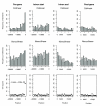Shuffling of cis-regulatory elements is a pervasive feature of the vertebrate lineage
- PMID: 16859531
- PMCID: PMC1779573
- DOI: 10.1186/gb-2006-7-7-r56
Shuffling of cis-regulatory elements is a pervasive feature of the vertebrate lineage
Abstract
Background: All vertebrates share a remarkable degree of similarity in their development as well as in the basic functions of their cells. Despite this, attempts at unearthing genome-wide regulatory elements conserved throughout the vertebrate lineage using BLAST-like approaches have thus far detected noncoding conservation in only a few hundred genes, mostly associated with regulation of transcription and development.
Results: We used a unique combination of tools to obtain regional global-local alignments of orthologous loci. This approach takes into account shuffling of regulatory regions that are likely to occur over evolutionary distances greater than those separating mammalian genomes. This approach revealed one order of magnitude more vertebrate conserved elements than was previously reported in over 2,000 genes, including a high number of genes found in the membrane and extracellular regions. Our analysis revealed that 72% of the elements identified have undergone shuffling. We tested the ability of the elements identified to enhance transcription in zebrafish embryos and compared their activity with a set of control fragments. We found that more than 80% of the elements tested were able to enhance transcription significantly, prevalently in a tissue-restricted manner corresponding to the expression domain of the neighboring gene.
Conclusion: Our work elucidates the importance of shuffling in the detection of cis-regulatory elements. It also elucidates how similarities across the vertebrate lineage, which go well beyond development, can be explained not only within the realm of coding genes but also in that of the sequences that ultimately govern their expression.
Figures







Similar articles
-
Evolutionary divergence of vertebrate Hoxb2 expression patterns and transcriptional regulatory loci.J Exp Zool. 2002 Oct 15;294(3):285-99. doi: 10.1002/jez.90009. J Exp Zool. 2002. PMID: 12362434
-
A survey of ancient conserved non-coding elements in the PAX6 locus reveals a landscape of interdigitated cis-regulatory archipelagos.Dev Biol. 2014 Mar 15;387(2):214-28. doi: 10.1016/j.ydbio.2014.01.007. Epub 2014 Jan 17. Dev Biol. 2014. PMID: 24440152
-
Variation in vertebrate cis-regulatory elements in evolution and disease.Transcription. 2014;5(3):e28848. doi: 10.4161/trns.28848. Transcription. 2014. PMID: 25764334 Free PMC article. Review.
-
The Evolution of Bony Vertebrate Enhancers at Odds with Their Coding Sequence Landscape.Genome Biol Evol. 2015 Aug 6;7(8):2333-43. doi: 10.1093/gbe/evv146. Genome Biol Evol. 2015. PMID: 26253316 Free PMC article.
-
New technologies, new findings, and new concepts in the study of vertebrate cis-regulatory sequences.Dev Dyn. 2006 Apr;235(4):870-85. doi: 10.1002/dvdy.20659. Dev Dyn. 2006. PMID: 16395688 Review.
Cited by
-
Multiple non-collinear TF-map alignments of promoter regions.BMC Bioinformatics. 2007 Apr 24;8:138. doi: 10.1186/1471-2105-8-138. BMC Bioinformatics. 2007. PMID: 17456238 Free PMC article.
-
Functional diversification of sonic hedgehog paralog enhancers identified by phylogenomic reconstruction.Genome Biol. 2007;8(6):R106. doi: 10.1186/gb-2007-8-6-r106. Genome Biol. 2007. PMID: 17559649 Free PMC article.
-
Conserved noncoding elements follow power-law-like distributions in several genomes as a result of genome dynamics.PLoS One. 2014 May 2;9(5):e95437. doi: 10.1371/journal.pone.0095437. eCollection 2014. PLoS One. 2014. PMID: 24787386 Free PMC article.
-
Identification and analysis of a conserved Tcfap2a intronic enhancer element required for expression in facial and limb bud mesenchyme.Mol Cell Biol. 2008 Jan;28(1):315-25. doi: 10.1128/MCB.01168-07. Epub 2007 Nov 5. Mol Cell Biol. 2008. PMID: 17984226 Free PMC article.
-
Highly conserved elements discovered in vertebrates are present in non-syntenic loci of tunicates, act as enhancers and can be transcribed during development.Nucleic Acids Res. 2013 Apr 1;41(6):3600-18. doi: 10.1093/nar/gkt030. Epub 2013 Feb 7. Nucleic Acids Res. 2013. PMID: 23393190 Free PMC article.
References
Publication types
MeSH terms
Grants and funding
LinkOut - more resources
Full Text Sources
Research Materials

